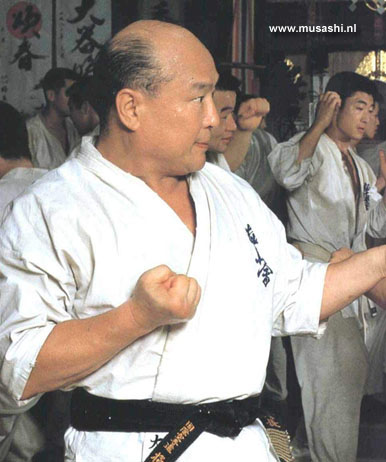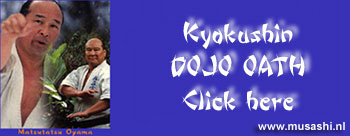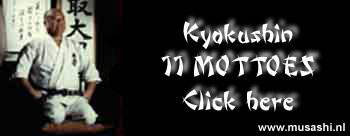![]()
![]()
![]()
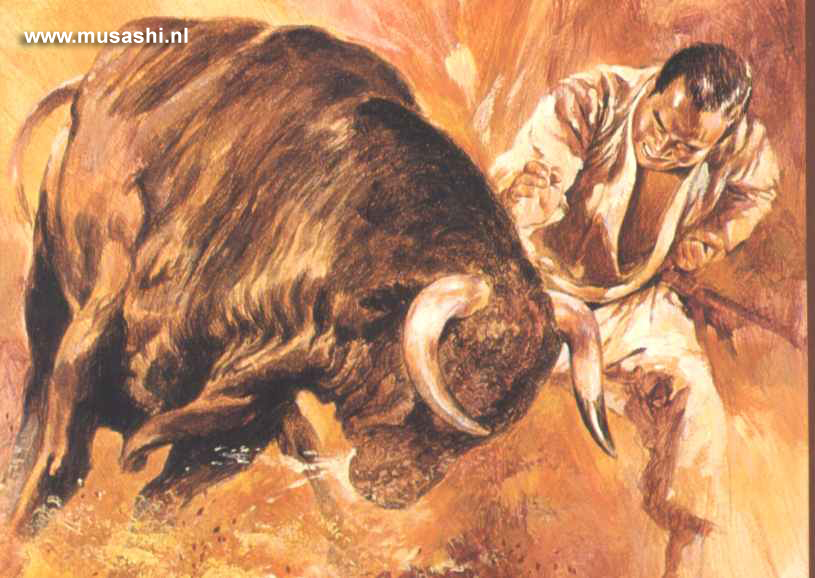
The Man The Legend. This is the History of one of the Greatest Martial
Artist whoever lived.
He was a legend in his own time.
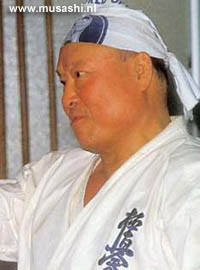 De
stichter (Sosai) van het Kyokushinkai karate, Masutatsu Oyama, werd
geboren als Yong-I-Choi in Qa-Ryong-Ri Yong-chi-Myo'n Chul Na Do, een
dorp niet ver van Gunsan in Zuid-Korea op 27 juli 1923. Hij was 4e zoon
of Sun Hyung uit een familie die bestond uit 6 jongens en 1 meisje. Op
jonge leeftijd verhuisde Yong-I-Choi naar zijn zus die leefde op een
ranch in Manchuria, een plaatsje in Zuid China. Yong-I-Choi had een
beschermde jeugd en hij moest iedere dag 6 miles lopen naar school over
een smal paadje over een heuvel naar
Yongree Primary School. Hij was daar één van de 400 leerlingen.
De
stichter (Sosai) van het Kyokushinkai karate, Masutatsu Oyama, werd
geboren als Yong-I-Choi in Qa-Ryong-Ri Yong-chi-Myo'n Chul Na Do, een
dorp niet ver van Gunsan in Zuid-Korea op 27 juli 1923. Hij was 4e zoon
of Sun Hyung uit een familie die bestond uit 6 jongens en 1 meisje. Op
jonge leeftijd verhuisde Yong-I-Choi naar zijn zus die leefde op een
ranch in Manchuria, een plaatsje in Zuid China. Yong-I-Choi had een
beschermde jeugd en hij moest iedere dag 6 miles lopen naar school over
een smal paadje over een heuvel naar
Yongree Primary School. Hij was daar één van de 400 leerlingen.
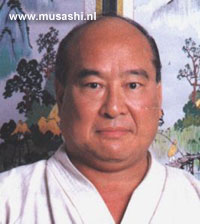 School
vond hij niks omdat hij niet van studeren hield. Eigenlijk speelde hij
veel liever hockey, of ging hij zwemmen of vissen. Rond zijn 9e jaar
kwam hij voor het eerst in aanraking met "the Martial Way" toen hij
begon met het leren van de zuidelijke Chinese vorm van Kempo, gekend als
"Eighteen Hands" of "Achttien handen". Zijn leraar was Mr. Yi die
tijdens die periode op zijn zusters boerderij werkte. Mas Oyama trainde
met Mr. Yi voor ongeveer 2 jaar; en bereikte de graad van Shodan.
School
vond hij niks omdat hij niet van studeren hield. Eigenlijk speelde hij
veel liever hockey, of ging hij zwemmen of vissen. Rond zijn 9e jaar
kwam hij voor het eerst in aanraking met "the Martial Way" toen hij
begon met het leren van de zuidelijke Chinese vorm van Kempo, gekend als
"Eighteen Hands" of "Achttien handen". Zijn leraar was Mr. Yi die
tijdens die periode op zijn zusters boerderij werkte. Mas Oyama trainde
met Mr. Yi voor ongeveer 2 jaar; en bereikte de graad van Shodan.
Nadat Mas Oyama terugkeerde naar Korea hij was toen 12, zette hij zijn
training voort met de Koreaanse martial art gekend als Taiken of Chabi.
Deze Koreaanse sport was een mengeling van Kempo, en overeenkomsten
vertoonde met Kung Fu en Ju Jitsu.
In 1938, op 15-jarige leeftijd, vertrok Mas Oyama naar Japan om daar als
piloot te trainen - zoals Bismarck, zijn idool in die tijd - aan het
Yamanashi Youth Aviation Institute. Overleven op zichzelf op die
leeftijd bleek echter moeilijker dan hij dacht, zeker als Koreaan in
Japan, en de vliegopleiding viel al snel in het water. Hij zette echter
wel zijn martial arts training voort met judo en boksen.
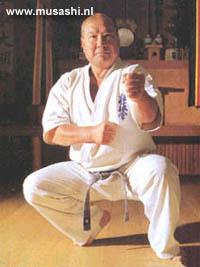 Toen hij naar
Japan migreerde, werd hij onder druk gezet om een Japanse naam te
kiezen. Hij koos Oyama wat "grote berg" betekende. Op een dag merkte hij
een student op die Okinawa Karate aan het trainen was en zijn interesse
hiervoor was zo groot dat hij zich aanmeldde als student bij de dojo van
Ginchin Funakoshi. Toen Mas Oyama Gichin Funakoshi ontmoette, de man die
het moderne karate in 1916 van Okinawa naar Japan bracht en een stijl
ontwikkelde nu gekend als Shotokan Karate, was hij zeer onder de indruk.
Mas Oyama oefende intens voor een lange tijd in de dojo van Funakoshi
aan de Takushoku University. Zijn vaardigheden en vorderingen waren van
dien aard dat hij op de leeftijd van 17 jaar al bevorderd werd tot Nidan
(2e dan), Wanneer Mas Oyama als 20-jarige dienst neemt in het Japanse
leger is hij reeds Yondan (4e Dan) in het Shotokan karate, een
ongelofelijke prestatie. Vanaf dat moment ging Mas Oyama zich ook
bekwamen in het Judo, een sport waar hij in minder dan 4 jaar de Yondan
graad behaalde.
Toen hij naar
Japan migreerde, werd hij onder druk gezet om een Japanse naam te
kiezen. Hij koos Oyama wat "grote berg" betekende. Op een dag merkte hij
een student op die Okinawa Karate aan het trainen was en zijn interesse
hiervoor was zo groot dat hij zich aanmeldde als student bij de dojo van
Ginchin Funakoshi. Toen Mas Oyama Gichin Funakoshi ontmoette, de man die
het moderne karate in 1916 van Okinawa naar Japan bracht en een stijl
ontwikkelde nu gekend als Shotokan Karate, was hij zeer onder de indruk.
Mas Oyama oefende intens voor een lange tijd in de dojo van Funakoshi
aan de Takushoku University. Zijn vaardigheden en vorderingen waren van
dien aard dat hij op de leeftijd van 17 jaar al bevorderd werd tot Nidan
(2e dan), Wanneer Mas Oyama als 20-jarige dienst neemt in het Japanse
leger is hij reeds Yondan (4e Dan) in het Shotokan karate, een
ongelofelijke prestatie. Vanaf dat moment ging Mas Oyama zich ook
bekwamen in het Judo, een sport waar hij in minder dan 4 jaar de Yondan
graad behaalde.
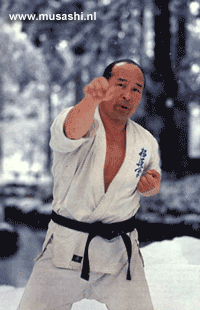 De eerst periode
na de westerse overwinning op Japan is voor Mas Oyama, en met hem voor
vele Japanners, vooral ook mentaal een moeilijke periode. In die periode
ontmoet hij So Nei Chu. Deze mede-Koreaan, levend in Japan, is een
autoriteit in de wereld van de Martial Arts en, naast zijn fysieke,
vooral bekend om zijn geestelijk kracht. Tevens ontmoet hij Eji
Yoshikawa, de schrijver van het boek Miyamoto Musashi, gebaseerd op
Japans bekendste Samurai krijger. Door de schrijver en het boek leert
Mas Oyama de de Samurai Bushido Code beter begrijpen.
De eerst periode
na de westerse overwinning op Japan is voor Mas Oyama, en met hem voor
vele Japanners, vooral ook mentaal een moeilijke periode. In die periode
ontmoet hij So Nei Chu. Deze mede-Koreaan, levend in Japan, is een
autoriteit in de wereld van de Martial Arts en, naast zijn fysieke,
vooral bekend om zijn geestelijk kracht. Tevens ontmoet hij Eji
Yoshikawa, de schrijver van het boek Miyamoto Musashi, gebaseerd op
Japans bekendste Samurai krijger. Door de schrijver en het boek leert
Mas Oyama de de Samurai Bushido Code beter begrijpen.
Onder invloed van So Nei Chu besluit Mas Oyama om zich op 23-jarige
leeftijd voor een periode van drie jaar terug te trekken uit het
maatschappelijk leven en zijn tijd volledig te wijden aan een
onmenselijke training van lichaam en geest. Hij vertrekt naar de berg
Minobu, de plek waar Musashi de zwaardvecht stijl Nito ontwikkelde. Mas
Oyama dacht dat dit de meest geschikte plaats was om zijn strenge
training te beginnen die hij voor zichzelf had gepland. Vergezeld door
Yashiro, een van zijn studenten, ging hij de wildernis in om er te
trainen, en een vriend die hen maandelijks voedselvoorzieningen bracht.
Maar na 6 maanden verliet Yashiro de berg, overwelmd door eenzaamheid,
Mas Oyama alleen latend om zijn training voort te zetten.
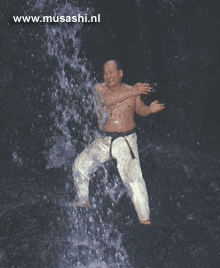 Na 14
maanden training in de wildernis informeerde zijn sponsor hem dat hij
niet langer de voedselvoorraden kon brengen en zo moest Mas Oyama zijn
eenzaamheid doorbreken en mede onder invloed van financiële factoren
keert hij voor een korte periode terug in de maatschappij.
Na 14
maanden training in de wildernis informeerde zijn sponsor hem dat hij
niet langer de voedselvoorraden kon brengen en zo moest Mas Oyama zijn
eenzaamheid doorbreken en mede onder invloed van financiële factoren
keert hij voor een korte periode terug in de maatschappij.
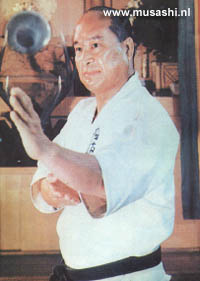 Een
paar maanden later, in 1947, testte Mas Oyama zijn kunde in de Karate
afdeling van het eerste "Japanese National Martial Arts Championships"
na de 2e Wereld Oorlog, dat hij won. Desondanks voelde Oyama zich nog
steeds leeg doordat hij zijn 3 jaar durende eenzame training moest
afbreken en besliste om zijn leven volledig aan karate te wijden.
Een
paar maanden later, in 1947, testte Mas Oyama zijn kunde in de Karate
afdeling van het eerste "Japanese National Martial Arts Championships"
na de 2e Wereld Oorlog, dat hij won. Desondanks voelde Oyama zich nog
steeds leeg doordat hij zijn 3 jaar durende eenzame training moest
afbreken en besliste om zijn leven volledig aan karate te wijden.
Opnieuw ruilde Mas Oyama de maatschappij voor de wildernis, deze keer
naar de berg Kiyozumi, ook in Chiba Prefecture, welke hij koos voor de
spiritueel verheffende omgeving. Deze keer was zijn training fanatiek en
zéér rigoureus en bestond uit een bijna onmenselijke training zonder
onderbrekingen van 12 uur per dag. Iedere dag, staande onder koude
beukende watervallen, rivierstenen breken met zijn hand, bomen gebruiken
als makiwara (Slagborden), springen over snelgroeiende vlasplanten voor
enkele honderden malen per dag.
In die periode waren wilde de dieren,
bomen, rivierstenen en rotspartijen zijn "tegenstanders" maar hij
overwon ze allemaal.
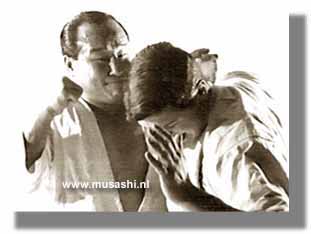 Tevens
besteedde hij tijd aan de bestudering van de vele oude vormen van de
vechtkunst, zen en filosofie en mediteerde hij urenlang in de ijskoude
watervallen.Zijn doel was het creëren van een stijl die terug ging naar
het echte vechten wat de samoerai vroeger deed. Gedurende deze harde en
lange training in de bergen combineerde Mas Oyama de meest effectieve
technieken van diverse stijlen en ontwikkelde zijn eigen stijl. Na 18
maanden barre training keerde Mas Oyama terug in de maatschappij, niet
alleen fysiek, maar zeker ook geestelijk, mentaal een andere, veel
sterkere man, dan de man die na de oorlog terugkwam in een ondermijnd
Japan.
Tevens
besteedde hij tijd aan de bestudering van de vele oude vormen van de
vechtkunst, zen en filosofie en mediteerde hij urenlang in de ijskoude
watervallen.Zijn doel was het creëren van een stijl die terug ging naar
het echte vechten wat de samoerai vroeger deed. Gedurende deze harde en
lange training in de bergen combineerde Mas Oyama de meest effectieve
technieken van diverse stijlen en ontwikkelde zijn eigen stijl. Na 18
maanden barre training keerde Mas Oyama terug in de maatschappij, niet
alleen fysiek, maar zeker ook geestelijk, mentaal een andere, veel
sterkere man, dan de man die na de oorlog terugkwam in een ondermijnd
Japan.
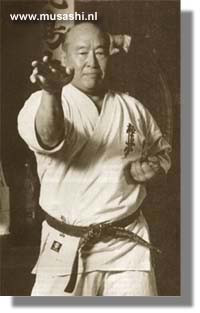 In
de jaren '50 begon Mas Oyama zijn kracht en kunnen te demonstreren door
het bevechten van stieren. In totaal bevocht hij er 52, waarvan hij er 3
onmiddellijk doodde en van de 49 anderen sloeg hij de hoorns af met een
enkele Shuto (meshand) slag. Wat niet wil zeggen dat het allemaal zo
gemakkelijk ging voor hem. Oyama verzweeg zeker niet dat zijn eerst
poging enkel resulteerde in een kwade stier. In 1957, op 34-jarige
leeftijd, werd zo een gevecht hem bijna fataal toen een stier hem in de
rug nam en die openscheurde. Door dit gevecht werd hij zwaar gewond en
het kostte hem 6 maanden om weer te herstellen van deze bijna fatale
wond.
In
de jaren '50 begon Mas Oyama zijn kracht en kunnen te demonstreren door
het bevechten van stieren. In totaal bevocht hij er 52, waarvan hij er 3
onmiddellijk doodde en van de 49 anderen sloeg hij de hoorns af met een
enkele Shuto (meshand) slag. Wat niet wil zeggen dat het allemaal zo
gemakkelijk ging voor hem. Oyama verzweeg zeker niet dat zijn eerst
poging enkel resulteerde in een kwade stier. In 1957, op 34-jarige
leeftijd, werd zo een gevecht hem bijna fataal toen een stier hem in de
rug nam en die openscheurde. Door dit gevecht werd hij zwaar gewond en
het kostte hem 6 maanden om weer te herstellen van deze bijna fatale
wond.
In April 1952 reisde Mas Oyama naar
de Verenigde Staten voor de eerste keer waar hij een jaar verbleef, zijn
Karate demonstrerend live op nationale televisie. Daar vocht Mas Oyama
tegen professionele boksers, worstelaars en iedereen die het waagde om
hem uit te dagen, in totaal 270 tegenstanders. Hij versloeg hen
allemaal, de meesten met een enkele aanval! Geen enkel gevecht duurde
langer dan 3 minuten en de meeste waren al over na enkele seconden. Mas
Oyama's vechttechniek was gebaseerd op het principe van de Samurai
krijgers, "Ichi geki, hissatsu", of "één stoot, zekere dood". Als hij
tot bij je kwam was het gevecht over. Als hij je sloeg, brak je — als jij zijn
slag blokte was je arm gebroken of ontwricht, indien je niet blokte was
je rib gebroken. Door zijn kracht en kunnen werd hij bekend als "the
Godhand". Voor hem was dit het echte doel van de techniek van Karate. De
mooie schoppen en en ingewikkelde technieken kwamen op zijn inziens op
de 2e plaats terwijl hij toch bekend was voor de kracht van zijn trappen
naar het hoofd.
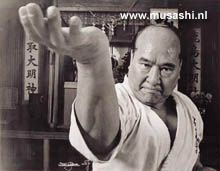
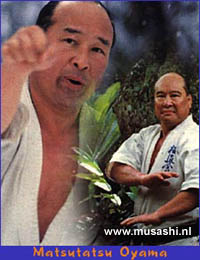 In
die tijd ontstond ook de 100-Men Kumite. Om zijn eigen mogelijkheden
verder te testen, besliste Mas Oyama om een driehonderd man kumite te
doen in 3 dagen. He koos de sterkste studenten uit zijn dojo om hem te
bevechten, één voor één. Nadat iedereen aan beurt was geweest, startten
ze terug van het begin totdat alle driehonderd gevechten voorbij waren.
Elke student van Mas Oyama moest het ongeveer 4 keer tegen hem opnemen
in die 3 dagen, terwijl sommigen niet eens door de eerste dag heelhuids
heen kwamen, vooral te wijten aan de krachtige uithalen van Mas Oyama.
De legende gaat dat Mas Oyama nog voor een vierde dag wou gaan maar dat
geen enkele tegenstander nog tegen hem wilde vechten, of er niet meer
toe in staat was.
In
die tijd ontstond ook de 100-Men Kumite. Om zijn eigen mogelijkheden
verder te testen, besliste Mas Oyama om een driehonderd man kumite te
doen in 3 dagen. He koos de sterkste studenten uit zijn dojo om hem te
bevechten, één voor één. Nadat iedereen aan beurt was geweest, startten
ze terug van het begin totdat alle driehonderd gevechten voorbij waren.
Elke student van Mas Oyama moest het ongeveer 4 keer tegen hem opnemen
in die 3 dagen, terwijl sommigen niet eens door de eerste dag heelhuids
heen kwamen, vooral te wijten aan de krachtige uithalen van Mas Oyama.
De legende gaat dat Mas Oyama nog voor een vierde dag wou gaan maar dat
geen enkele tegenstander nog tegen hem wilde vechten, of er niet meer
toe in staat was.
In 1954 opende Mas Oyama zijn eerste
dojo op een perceel gras in Tokyo. Maar juni 1956 wordt toch gezien als
de echte start van de Oyama karate school omdat hij toen zijn dojo
achter de Rikkyo Universiteit opende, 500 meters van het huidige Honbu.
In 1957 trainde er 700 leden ondanks het grote aantal uitvallers door de
zeer zware trainingen. Beoefenaars van andere stijlen kwamen ook in de
dojo trainen voor de jis-sen kumite (full contact vechten). Mas Oyama
observeerde die andere stijlen dan en zou de bruikbare technieken voor
een gevecht inpassen.
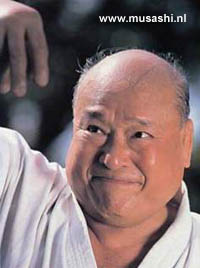 Door
dit te doen evolueerde Mas Oyama's Karate in een van de meest
indrukwekkende stijlen in de wereld van gevechtskunsten. De stijl werd
al snel bekend als "The Strongest Karate", niet alleen door de
ongelooflijke kracht- en uithoudingsprestaties die Mas Oyama opbracht,
maar ook door de strenge vereisten voor training en wedstrijden.
Door
dit te doen evolueerde Mas Oyama's Karate in een van de meest
indrukwekkende stijlen in de wereld van gevechtskunsten. De stijl werd
al snel bekend als "The Strongest Karate", niet alleen door de
ongelooflijke kracht- en uithoudingsprestaties die Mas Oyama opbracht,
maar ook door de strenge vereisten voor training en wedstrijden.
 De
Oyama Dojo leden namen hun kumite serieus, het primair als een
vechtsport beschouwend, dus ze verwachtten om te slagen en geslagen te
worden. Met weinig restricties, aanvallen naar het hoofd waren normaal,
meestal with de palm van de hiel of met de vuisten, in handdoeken
gewonden. Vastnemen, worpen en aanvallen naar het kruis kwamen ook veel
voor. Kumite rondes duurden zolang totdat iemand luidkeels opgaf.
Blessures gebeurden op dagelijkse basis en het opgeefpercentage was
enorm hoog (meer dan 90%). Ze hadden geen officiële do-gi en droegen wat
ze hadden.
De
Oyama Dojo leden namen hun kumite serieus, het primair als een
vechtsport beschouwend, dus ze verwachtten om te slagen en geslagen te
worden. Met weinig restricties, aanvallen naar het hoofd waren normaal,
meestal with de palm van de hiel of met de vuisten, in handdoeken
gewonden. Vastnemen, worpen en aanvallen naar het kruis kwamen ook veel
voor. Kumite rondes duurden zolang totdat iemand luidkeels opgaf.
Blessures gebeurden op dagelijkse basis en het opgeefpercentage was
enorm hoog (meer dan 90%). Ze hadden geen officiële do-gi en droegen wat
ze hadden.
In
juni 1964 werd het huidige Honbu (het wereld hoofdkwartier) officieel
geopend en de naam "Kyokushin", of "Ultieme Waarheid"
werd aangenomen voor Mas Oyama's Karate organisatie, de "International
Karate Organization" (IKO). Van toen af aan spreidde het Kyokushin
Karate zich uit over meer dan 120 landen met meer dan 15 miljoen
beoefenaars, wat inhield dat het Kyokushin een van de grootste
gevechtsstijlen ter wereld is geworden. In 1974 werd Mas Oyama geëerd
voor zijn werk met de 9e Dan en kort daarna zelfs met de 10e Dan, de
hoogst haalbare graad in de wereld, door het internationaal comité van
landenvertegenwoordigers.
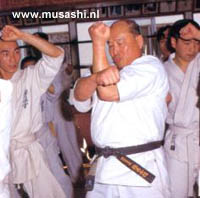 In april 1994 stierf Mas Oyama op een
leeftijd van 70 jaar aan longkanker. Mas
Oyama's onverwacht overlijden liet
zijn organisatie in een zeer verwarde staat achter. Voor zijn dood,
verklaarde hij in zijn testament dat Yukio Nishida zijn opvolger zou
zijn om de IKO te leiden, maar op zijn sterfbed benoemde hij spontaan
Akiyoshi Matsui, toen Yondan (4de Dan). Terwijl Matsui wel bedreven was,
in Kyokushin Karate en in het managen van de organisatie, namen veel van
de hogere yudansha (zwarte banden) en Branch Chiefs uit de organisatie
aanstoot aan dit feit.
In april 1994 stierf Mas Oyama op een
leeftijd van 70 jaar aan longkanker. Mas
Oyama's onverwacht overlijden liet
zijn organisatie in een zeer verwarde staat achter. Voor zijn dood,
verklaarde hij in zijn testament dat Yukio Nishida zijn opvolger zou
zijn om de IKO te leiden, maar op zijn sterfbed benoemde hij spontaan
Akiyoshi Matsui, toen Yondan (4de Dan). Terwijl Matsui wel bedreven was,
in Kyokushin Karate en in het managen van de organisatie, namen veel van
de hogere yudansha (zwarte banden) en Branch Chiefs uit de organisatie
aanstoot aan dit feit.
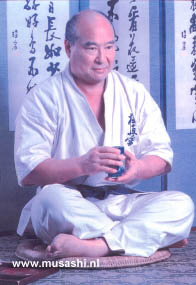 Dit
resulteerde in een versplintering van de IKO in 4 groepen. — de IKO 1
onder shihan Akiyoshi Matsui, de IKO 2 onder shihan Kenji Midori, de IKO
3 onder shihan Yoshikazu Matsushima en de IKO 4 onder shihan Toru Tezuka.
Elke Japanse groep zegt de echt opvolger te zijn voor Mas Oyama’s
organisatie en sindsdien is de Kyokushin wereld verwikkeld in een zware
machtsstrijd om het leiderschap.
Dit
resulteerde in een versplintering van de IKO in 4 groepen. — de IKO 1
onder shihan Akiyoshi Matsui, de IKO 2 onder shihan Kenji Midori, de IKO
3 onder shihan Yoshikazu Matsushima en de IKO 4 onder shihan Toru Tezuka.
Elke Japanse groep zegt de echt opvolger te zijn voor Mas Oyama’s
organisatie en sindsdien is de Kyokushin wereld verwikkeld in een zware
machtsstrijd om het leiderschap.
Buiten Japan is er nog een 5e en 6e groep Kyokushin karateka die zich
aansloot bij de IKF onder Hanshi Steve Arneil uit Groot-Brittannië en
bij de IBK onder Kancho Jon Bluming uit Nederland. Deze beide niet
Japanse organisaties geven nog steeds les in het traditioneel Kyokushin
Karate zoals het oorspronkelijk werd gedaan door Mas Oyama.
Mas Oyama ontwikkelde niet alleen een
geweldige effectieve gevechtsstijl maar gaf ons ook de Kyokushin
levensfilosofie mee. Hij was mijn inziens één van de allerbeste
karateleraren in de geschiedenis en hij leidde vele goede instructeurs
op die mee hielpen aan het groot maken van zijn kyokushin organisatie.
Hij liet ons iets na waar we met zijn allen duidelijk trots op kunnen
zijn.
Hier is zijn Kyokushin Ideaal:
Keep your head low (modesty), eyes high (ambition),
mouth shut (serenity),
base yourself on filial piety and benefit others.
Met respect voor onze enige en échte leider
Osu !!
Sjaak van de Velde.
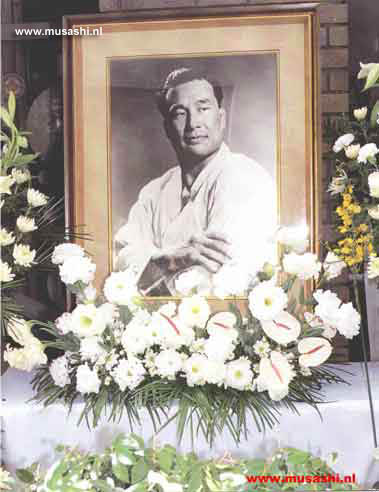
Philosophical Thoughts by Sosai Mas Oyama
“One becomes a beginner after one thousand days of training and an
expert after ten thousand days of practice."
"Although it is important to study and train for skill in techniques,
for the man who wishes to truly accomplish the way of budo, it is
important to makehis whole life in training and therefore not aiming for
skill and strength alone, but also for spiritual attainment."
"A human life gains luster and strength only when it is polished and
tempered."
"Reading good books implants good ideas in the mind, develops good
aspirations, and leads to the cultivation of good friends."
"One living daily in the Way carries their head low and their eyes high;
reserved in speech and possessing a kind heart, they steadfastly
continue in their training efforts."
"Aspirations must be pure and free of selfishness. Arising from the
depths of the soul, aspirations are spiritual demands penetrating all of
a human life and making it possible for a person to die for their sake.
A person without aspirations is like a ship without a rudder or a horse
without a bridle. Aspirations give consistent order to life."
"As far as possible, I want nothing more than to don my training gi and
teach Karate."
"If someone asked me what a human being ought to devote the maximum of
his life to, I would answer: training. Train more than you sleep."
"Karate is the most ZEN-like of all the martial arts. It has abandoned
the sword. This means that it trascends the idea of winning and losing
to become a way of thinking and living for the sake of other people in
accordance with the way of Heaven. Its meanings, therefore, reach the
profound levels of human thought."
"One must try everyday to expand one's limits."
"Behind each triumph are new peaks to be conquered."
"Until the day I die, I never want to be separated from my dogi; I never
want to cease my training efforts in the dojo."
"The fastest way to attain courage is to follow the chosen Way and be
willing to abandon life itself for the sake of justice."
"If you have confidence in your own words, aspirations, thoughts, and
actions and do your very best, you will have no need to regret the
outcome of what you do. Fear and trembling are lot of the person who,
while stinting effort, hopes that everything will come out precisely as
he wants."
"Human beings are capable of virtually limitless degradation; they are
also capable of virtually limitless improvement and achievement. Success
depends on goals and on diligence in pursuing them."
"Always remember that the true meaning of Budo is that soft overcomes
hard, small overcomes large."
"The most significant life is the one lived on the basis of a personal
sense of justice and the desire to see justice realized everywhere."
"It is possible for even the smallest of accolades of achievement to be
truly worthwhile without tears and toil?"
"I realized that perseverence and step-by-step progress are the only
ways to reach a goal along a chosen path."
"Subjecting yourself to vigourous training is more for the sake of
forging a resolute spirit that can vanquish the self than it is for
developing a strong body."
"Each of us has his cowardice. Each of us is afraid to lose, afraid to
die. But hanging back is the way to remain a coward for life. The Way to
find courage is to seek it on the field of conflict. And the sure way to
victory is willingness to risk one's own life."
"We in Kyokushin maintain faith in the Way that knows no prejudices."
"My Way is the Way of Karate, which is also the Way of humanity, and
which is consequently related to the Way of Heaven."
"A man who understands decorum and the courtesies is a great treasure; I
hope to train and send into society as many such men as I can."
"No matter how strong the rival, the just will always win."
"True courage is born only when it is accompanied by justice."
"Courtesy should be apparent in all our actions and words and in all
aspects of daily life. But be courtesy, I do not mean rigid, cold
formality. Courtesy in the truest sense is selfless concern for the
welfare and physical and mental comfort of the other person."
"Karate is Budo and if Budo is removed from Karate it is nothing more
than sport karate, show karate, or even fashion karate-the idea of
training merely to be fashionable."
"I have not permitted myself to be ignorant of any martial art that
exists. Why? Such ignorance is a disgrace to someone who follows the
path of the martial arts."
"If you do not overcome your tendancy to give up easily, your life lead
to nothing."
"Sice Karate exists for cultivating the spirit and training the body, it
must be a moral way surpassing mere techniques..."
"Power is no more than a part, no more than the tip of the iceberg of
limitless profundity and sublimate of Karate."
"In the martial arts, introspection begets wisdom. Always see
contemplation on your actions as an opportunity to improve."
"Studying the martial Way is like climbing a cliff: keep going forward
without rest. Resting is not permissible because it causes recessions to
old adages of achievement. Persevering day in, day out improves
techniques, but resting one day causes lapses. This must be prevented."
"Personal greed and egoism are things that cause human beings to forget
respect for others and to violate rules that have been established for
the sake of peace and friendship."
"Come ye trials and challanges; come life's big waves, for I am ready?"

Osu!!
Old message to the Kyokushin members by Sosai Mas
Oyama
I'll Take a Bet On Fighting Spirit!
On May 10, 1978, in Nara, the ancient
capital of Japan, Kancho Oyama gave a speech at a Public Seminar in
which many prominent people from throughout Japan were also invited to
speak. As in all Kancho Oyama's speeches, he spoke without the aid of
any notes, and without having previously planned anything. The speech
was some two hours in length. I'm not the kind of person who usually
gives speeches on such a big stage, and I think perhaps I had better do
a Karate demonstration, rather than speak, so that you can all feel
satisfaction. But I can only talk about Karate, because I only know
about Karate. I'm not a politician, nor a good speaker, and I'm neither
a businessman nor a leader. I'm just a Karate-Ka. So I'll just talk
about Karate. Karate came from Okinawa 46 years ago. Mr. Funakoshi, who
did much to make it popular, brought it to Japan. But Japan already had
a similar art called Jujutsu, which developed from Koppo. Koppo became
Yawara. Yawara became Jujutsu. Jujutsu became Judo, Karate and Aikido.
Judo has throwing, strangles and ground holds, and originally was
divided into 2 systems. 1) Kodokan Judo, specializing in throwing and
based in Tokyo, and 2) Butokukai, based in Kyoto and specializing in
ground holds.
The Butokukai was, however, greatly influenced by the Japanese right
party and was consequently disbanded by General McArthur after the
Second World War. Before the war, the Butokukai and the Kodokan held a
yearly inter-competition. This was perhaps the best time in Japanese
Judo; it grew rapidly and became known overseas. I think most people
know of the development of Judo from this point. So how did Karate grow?
The Kyokushin-KaiKan now has dojos in 96 countries, but I didn't
originally have the idea to open dojos overseas. It was only when I
could no longer eat in Japan that I agreed to the suggestion of a
teacher of the Butokukai, and went overseas to the USA. If I had been
able to feed myself here in Japan maybe this would never have
happhappened and my life now (would be) quite different. Anyway, I
looked around a world that then did not know Karate, and in the 30 years
that have passed since that time, Karate has grown quite remarkably. Why
did Karate become popular so quickly? There are two reasons. One, though
of course Karate training is hard and takes a long time, it is still
easier to learn to use in a much shorter time than Judo or Aikido. And
secondly, there is no need to hold or grasp at your opponent in Karate.
When I was young, during the time of World War 11, I was attending
Takushoku University. I also went to a Karate dojo for daily training.
The teacher there told me that recently I had become very strong, and I
really had gained the confidence that I could beat anyone with my punch.
I had gained power in all the techniques of Karate, and when I punched
anyone, they would fly up 30crn in the air and then fall to the floor.
At this time my Sempai looked very small to me. Whenever you are in good
condition, you feel that others are small. But one teacher told me that
although I had become very strong in only one year of training, I had
also developed a very big head. I felt inside me at the time, that I
could easily beat this old teacher with one punch, and I eyed my teacher
with belligerence. The teacher told me that it takes 3 years to learn to
form the seiken, 3 years to develop stance and 3 years to develop a
punch, and that if you want to master Karate, it takes at least 9 years.
But I still continued to think that my Karate was best, my head was
indeed very big.
Soon after this, I was drafted into the army, and by the time I had
returned from the war, my teacher had already passed away. 30 years have
now passed and people call me a Master of Karate or "Karate God". But
I'm just human, and now I'm finding that I am questioned by the things
as seemingly as simple as how to form a fist; things I had not
considered before. It is almost like the case of, the more I study, the
more I realize just how much more there is still left to study. A person
who studies Karate for only 3 months can use it practically with the
same 3 months of training. Karate is very useful, but to MASTER it is
very hard. I'm now 55 years old, and I'm still wondering, what is
Karate? Now the world population is more than four billion, but I would
say a good half of the people have at least heard the word, Karate.
Karate is an International phenomenon, and is no longer Japanese.
Recently I have felt this realization very strongly. Japan has become
very famous in the economic world, but I believe the only real thing the
Japanese have got to show the world is Budo. But maybe I say this
because I'm a "Karate-Baka"(Karate-fool). If you have a Karate Shodan
you can consider your chances of one against five as being 50/50. In the
USA and Europe, Karate has become very popular because Europeans,
especially ladies, didn't like the holding in Judo. The charm of Karate
is that both can keep a distance, and that when forced to come together,
only one falls over. Karate training can develop a smart walk, as can
Kendo, and both Kendo-Ka and Karate-Ka walk the same way. In old Japan,
one of the Karate tests was to soak rice paper with water and walk on it
without ripping it. We think we can judge the strongest people by
watching the Olympics, that is; the Olympic Judo Champion is the
strongest.
But we can make better records and results by a type of effort that has
nothing to do with the Olympics, even though medical doctors may disown
such acts as nonsense. For example, a monk, who was dying by fire, said
that he could feel no pain nor any heat, so long as he kept nothing in
his head. I believe in this ability, I have seen and felt it. One kempo
teacher brought a hand being burnt. If you haven't seen this kind of
act, perhaps. You can't believe it, but the secret is to forget that the
hot water is hot. Scientist can't say how these things happen, but
nevertheless they happen. At this point scientific knowledge doesn't
cover everything. People ask me what is Kyokushin, Well, an old Budo-Ka
once said that 1000 days of Karate training makes a beginner, 10,000
days makes a master. Master = Kiwameru = Kyoku. Shin = truth, therefore
Kyokushin = to master the truth; to seek for the ultimate. Karate is a
very simple art, but in comics and movies it is always portrayed with
fancy movements. This is just business; the movies aren't always
truthful. It is just a case of "You have put flowers to the leaves in
order to make money". Actually Karate is a very simple thing, but simple
things are boring, so moviemakers and many dojo-owners have to add spice
to make it sell. Today many young people are chasing after the flower.
But I knew one young man, a university teacher, who took one year's
holiday and came to Tokyo to study Kyokushin-Karate. He felt the
training was very hard and simple, with the same techniques being
repeated 1000s of times everyday. To him it was not a fight against
others but a fight against himself. This is Karate. Sometimes people say
that Kyokushin-Karate is "Kenka- Karate"(street-fighting Karate). At
first people called Kyokushin-Karate "misconceived Karate", then
"street-fighting Ka- rate", and now they call it "real-fight Karate".
But I want to make my Karate "soul spirit Karate". Today's Karate has
undergone great changes. Before when foreigners met Japanese in their
countries, they imagined Judo. However, if you practice Judo you develop
a bad figure, you injure you face and scars and your walking becomes
very slow. Judo-Ka cannot handle street-fights. I think you have seen
Popeye cartoons before, haven't you? In these stories, Brutus, who has a
big body always loses against the little Popeye. In the USA I saw many
people like Brutus. They were very powerful and strong, they could even
break cola bottles between their arms. If you are caught by this kind of
person, you will surely lose, but their movements are slow and in their
fighting they always try to catch and hold. Maybe they can work in
Pro-wrestling, but they are useless in street fighting. You can see many
guys around with big muscles on the beaches of Miami, but the true
strong ones have less showy form, slimmer figures. In the street fight,
the muscled type can't catch the thinner type because too many muscles,
which in fact they really don't need to have in order to fight
effectively, hamper them.
I first heard this saying when I was in the USA. Ballet Dancers are good
fighters. Oh I'm sorry, I'm only talking about fighting, but anyway, I
hope it's interesting for you. You know, Ballet dancers have a very nice
walk and slim, strong bodies. In fighting they can fight very
rhythmically. I had one ballet dancer friend who liked to fight. Once
when I was out with this dancer, he started to fight against others,
eventually I had to help him out, but at first when I was just watching,
I was very impressed with his rhythmical movements, despite his funnily
formed fist. Our lives have rhythms. It means we are living rhythm.
Those that lose the rhythm of life become ill. A good musician can be a
good Karate-Ka. Even one who just loves and listens a lot to music can
be very good at Budo. Many famous people have also been musicians, and 1
think most Budo-Ka love music and can play some instrument. A person
with bad rhythm can't be good at Karate. Walking is a rhythm, waking up
and washing your face is a rhythm, and one shouldn't break these
rhythms. Sometimes people break these rhythms. Sometimes people break
their rhythm because of work, and some don't appear to have any rhythm
at all. For example, many years ago, I went to a town in New Jersey,
USA, to become the private teacher of a Bodybuilding teacher. In the
first week, I found that my student always moved backward when he was
supposed to move forward. I asked him if he liked music, and when he
answered that he hated music, I apologized and left, saying that you
simply can't learn Budo without rhythm. I have already talked about my
going overseas. Many Japanese are traveling abroad these days, but it is
not with- out some problems. For example, the President of the Brazilian
Japanese People's Organization, Mr. Fuji, said to me that many people
are beginning to feel antagonism towards Japanese because Japan has
become an economical animal. He told me of how some Japanese came to
Brazil, opened a Bank and collected money from the Brazilians, only to
escape half a year later, and how many Japanese sponsored companies are
paying small pitiful wages. He asked me how we could clear up the bad
feeling, and then answered himself by asking me to please send him many
Japanese Karate-Ka. At present many dojos in Brazil are unused, but if I
were to send instructors they would all begin again teaching Kyokushin.
Mr. Fuji, whose son is training Karate, is convinced that Karate is
truly the greatest discipline. Judo has a lot of throwing, which is a
nice feeling, but it isn't so nice to be thrown, and it can cause spine
injuries to youngsters. Today's Judo is just a lot of grabbing and
pushing, and in Kendo you need to have too much heavy and ex- pensive
equipment. At any rate Mr. Fuji said that Karate is wonderful because
you can train alone, and that it's very popular in Brazil. Actually,
Karate is popular everywhere. Because Karate comes from Zen years
before, Karate had a very bad image. Judo was the powerful might and
Karate was always the "bad". Karate was associated with gangsters and
always lost to Judo in the people's minds, in books and in movies.
Fortunately Karate doesn't have this image today, be- cause it
eventually became known that Karate and only Karate comes from Zen.
Karate starts from spirit training, from Zen. Other Budo may develop Zen
and spirit training, but Karate starts from spirit training. I studied
Judo in the Kodokan, and I know very well that only Karate starts with
and from spirit training. Karate's profound relationship to Zen has made
Karate popular the world over. Karate is Zen. European people are people
who don't believe anything without looking for evidence. If you say you
can break a whisky bottle, they say "Show me". I went to USA just after
the war and I received many insults of "Kill the Jap." However, after I
demonstrated my art to them, they could forget their prejudice and
follow my way. When I was in USA I broke the tops off 12 bottles in one
go. Long thin neck bottles are easy to break and short, thick ones are
hard, says physics. I demonstrated this to my audience. First I adjusted
my breathing (the most important thing in Karate), and then I broke all
the bottles continuously, sometimes two or three at a time. Everyone
saluted me and respected me; I had shown evidence of my words. . Western
people are big and Japanese are small, but you can stop a person getting
out of a chair with one finger; it has nothing to do with size. In USA
you have to prove yourself to be believed, grid if you aren't believed
you can't live. Fortunately, 1 was believed. After this the fee 1 could
ask for lessons tripled. Americans are very interesting; when you charge
a higher price the people feel the lesson has better quality, and you
gain more respect!
During my trip to France, things didn't go nicely with the promoter and
we split. I had nowhere to go, so I slept on a park bench. I couldn't
speak French and my English wasn't so good either. Actually, when I was
in the USA the promoter told me not to speak so much because they
believe great oriental men don't say much, so I unfortunately took this
ad- vice and never really learned much English. Anyway, I started
teaching in France to a company driver but when it failed, I took a job
in a cabaret breaking bottles as my act. After one week, however, I was
told that breaking wasn't so popular and could I do something else. An
Embassy's friend of mine suggested that I do walking on my hands, so I
did an act hand walking up and down a spiral staircase. It was very
hard, especially coming down! I was very afraid, but at the time, my
greatest fear was starving. The fear of starving really makes one
strong. When I returned to Japan, I told my wife that it was through
that hand-walking act that I had lost all my hair and gone bald! But
behind sport everyone is forgetting Budo. Now, here in Japan, baseball
is very popular, and all students seem to love the sport and dream to be
professional players. People who have big bodies or can run fast are
pulled into the baseball club. I'rn not saying that baseball is bad, but
too many people are crazy about it. Baseball, however, is only popular
In Japan and the USA, and this is why there is no world tournament. It
may even be why Japan can't win so many medals in the Olympics. I am
always asking the sports committees in Japan to put a bit more power
into some other sport beside baseball. Why do we forget Budo, which
incorporates old Japanese spirit? Budo is as good as sport. Now I am no
longer sure of the future of Japanese Karate. I am not sure if we can be
the strongest for much longer. 30 years ago it was new to everyone, but
this is not so now, and even the communist countries know Karate. Now in
Karate knowledge and Karate history, there isn't such a great difference
between Japan and other countries. Karate is changing from white
people's power Karate to Black people's jump Karate. If Black people
train more, one day Japan will lose to them. Today's Japanese don't pay
enough attention to Budo. Foreigners come to Japan especially to learn
Karate and they spend much of their life savings, but the Japanese who
can easily learn it, don't bother to do so. However, I am happy to note
that there are some younger people who want hard training. Sport means
to enjoy, but Budo means to be hard to yourself, and to make yourself
strong. Today most of our youngsters don't have any moderation, they
can't work within the proper limits, or change according to
circumstances. So many of them are doing things that go against Human-Do
(way). . But over the past 2 or 3 years, I believe the situation has
improved a little. Many new students are coming to Kyokushin daily,
because they really want a harder time, a stricter, more disciplined
life. Japan has many Karate styles, but Kyokushin is the strictest. Hard
to yourself, kind to others; this is Budo, and this is why I insist that
Kyokushin remains strict. Recently 88 out of every 100 of my students
wrote that they want strict training. 3 years ago most said that they
wanted to do Karate at their own pace, as a hobby.
People who study Karate also study etiquette and develop good and
pleasing manners. For many years the Japanese themselves were very
prejudiced against Karate, but Karate is the only Budo that studies
spirit. Even in foreign countries they make little shrines, and bow to
them in Japanese style. They place the Japanese flag in their dojos
along with their own country flag, and after training they clean up in
Japanese fashion. Maybe you (the audience) can't suppose this, but what
the foreigners want from Japan is not money or economic things, they
want Budo spirit. Budo spirit means Karate spirit, and Karate spirit
means Kyokushin. Kyokushin means 1000 days a beginner, 10,000 days a
master. By this we mean that you must be hard to yourself and kind to
other people. The way to study being hard to yourself and kind to others
is through Budo. Now I can see a number of students challenging all
hardships in training, and it is very pleasing to me. Of course
Kyokushin's training is hard, but it doesn't mean it's violent. We don't
kill anyone in training, as it often happens in some university cheer
clubs here. I always tell my instructors to be hard to themselves that
they should never order the students to do 1000 kicks until they
themselves have done it. I tell them they may only order 300 press-ups
if they too do it, and I stress that they shouldn't be lazy, shouldn't
be soft on themselves and hard to the others. Too many people these days
are soft to themselves and hard on others, they should study the way of
Budo, the way of Karate, Kyokushin-Karate.
Sometimes at midnight I have a period of self-criticism and analysis.
Who is Oyama Masutatsu? What am I? I'm not a person with great
leadership ability and I'm not a businessman or a politician. So what
and who am I? I'm a bugeisha, a person who fights everywhere, always. I
am a person who only trains Budo. But even a strong gunman becomes weak
when he gets old, and a good horse can't be a good horse forever. What
does a Bugeisha do when he becomes old and finds someone stronger than
himself'? At this time, he can escape. A long time ago I was talking
about Karate in front of a politician, and when he asked me what I want
to do next in my life, I answered that I think the destiny of my life
can only be one way; I will become a monk. When I was young I tried to
enter a Buddhist Temple, but unfortunately I couldn't join at the time.
I told them that when I became old I would come again, and they were all
much surprised. You see, I am a bugeisha, I'm not a leader. Spirit is
the most important thing. I wanted to be today's Miyamoto Musashi. Then
the war came. It just happened to be that I did not die in the war, but
after the war, and even now, I felt very sorry for my friends who did
die. So I started living for Karate, and I suppose I will even die for
Karate. I traveled around the world and became the Head of an
International Organization. I chose and set out on the left road, and
ended up walking on the right road. Me! Oyama Masutatsu, became an
organization Head. When I suddenly woke up and realized this and its
implications, it was already too late. Sometimes I am asked why I always
so deeply respect Miyamoto Musashi. It is because of his strength, He
could defeat anyone in a fight, even his parents, child, teacher and
friends. I could learn from him, that you have to win. When you fight
you shouldn't think of any other thing, you should fight and win. I also
have a Sempai whom I greatly respected. I so respected Mr. Kimura, the
Judo-Champion, that during the early stages of the war, I even went to
Takushoku University because Kimura was at this university. He was like
my God then, and I believed that he was the Miyamoto Musashi of the
present day. I tried to be like him in every way, as I wanted to be
every bit as strong. Unfortunately, I was soon drafted into the army.
After the war I kept contact. with Kimura and visited his house, and he
was always very kind to me. He taught me many things - judo,
pro-wrestling, and when I was in the USA, he was particularly kind and
helpful to me. After a few years however, Kimura changed to
pro-wrestling, but he lost many fights because of the pro-wrestling
business tricks. Once he had lost, people became cold to him. In the
fighting world, you simply have to be a winner. When you win everyone
listens to you, but no one listens to a loser. After you lose, no one
hears your excuse, even if it is a good and valid one. Winning is
"man's" way, and fighting is man's "romance?
I respect a person who shows his fangs in a fight. I feel a great
attraction and charm to any fighter. I despise those who try to cover
themselves even if they are rich and "great". I respect a person who is
always fighting in life. I respect all fighters, even if they are my
enemies. If I have such a student, I want to help him very much in
anyway I can. Today's young people are only thinking about graduating a
good university so that they can get a job in a big company and have a
beautiful wife and a prestigious car. They don't have any fighting
spirit, they don't try to fight in life. One University Medical Doctor,
Vice-President of his department, came to Tokyo just to train Karate
some years back now. He took a long holiday from his university, and
trained very hard. He was a fighter. If you don't have any fighting
spirit you are a useless man and your life has no value. You have to
fight, to challenge.
Oyama Masutatsu, have you ever lost a fight before?Yes, I have lost many
times. Just after the war, I was bashed up by a group of blacks and was
even hospitalized, but man-to-man I have never lost clearly. I have only
lost trying to fight against five or six people, because I am no God or
Superman. One instance of "losing" even proved highly valuable for me.
This was during my meeting with Mr. Ching in Hong Kong. I loved the
personality of Mr. Ching, and I respected him very deeply. When I met
him I was 33 years old and he was nearly 70. I am now bald, but even at
that time, although he was very old, he had more hair then than I do
now, and he was only around 50kg in weight. Of course I had more power
and speed than he had, as I was young, but he was a magnificent man,
just like an old God. My head was bowed the whole time that I was in his
presence, as I couldn't look at him directly. I had lost to him without
doing anything. He asked me to show him my techniques, and I showed him
all that I knew. He said that it was wonderful and dynamic, but still
with an edge on it. He said I was like a rough diamond and I needed
polishing. I asked him to teach me but he answered that he didn't really
have anything to teach me, just that I had forgotten the definition of
Karate and my movements had become too straight. He said, draw a circle
and have a spot on it. A straight line is plus alpha. He said that
straight Karate was just gymnastics, but you only beat people when you
have power, true power that comes from the point and circle. Since that
time I have been teaching all my students the same thing, and this is
why Kyokushin Karate is different from other Karate styles. The life of
Kyokushin Karate is Kumite(fighting). The life of Kumite, fighting, is
in basics. You have to practice circle training. One should never show
ones back to the enemy, you must try to get him from behind. If you are
to the side of your opponent you can win 60% of the time, if in front
perhaps 50%, but if you can get to the back of your opponent you can win
70-80% of the time. Students must train how to come in from behind.
You can be strong by studying Karate. I think most people find a great
charm in the idea of becoming, strong. Every individual must be strong,
if you want to join Kyokushin, then I take it as my responsibility and
duty to teach you. But if you cannot get the secrets, the knowledge
about Karate and yourself', by yourself, then I can't help you. If you
train the same technique 100,000 times then suddenly you may understand,
"Oh, this technique is like this". Maybe one night you will suddenly see
the light, "Oh, this kick is this way". This is the way to get the
secrets, the knowledge about Karate and yourself. Every country seems to
have a saying similar to "you can lead a cow to water, but you cannot
make it drink", whether the cow drinks or not, is over to the cow.
Teaching may be the duty of myself or the sempai, but whether you become
strong or not is your own problem. Since old times we have had the idea
that secret techniques are given by the teacher, but this is nonsense.
The secrets, the knowledge can't be given by any teacher, you have to
grasp it yourself with your own hands. Can you be strong if your parents
give you money? It is over to you, as to whether you can be happy and
strong or not, it has nothing to do with your parent's wealth.
Everyone must have water and air to live. If we didn't have enough of
these, then people would fight for them. Even if you are rich, have
money, power and food, you will die without air. Breathing is most
important in Karate. We have Ibuki breathing in Karate. It has an
outside and inside character: it is positive and negative. When others
are unaware that you are breathing, then this is negative breathing, and
the breathing that surprises others is positive breathing. Positive and
negative breathing is called Ibuki. Breathing in slowly is negative,
bringing up the air to the chest and breathing it out with a loud sound
is the positive aspect. It is very important breathing, for it calms the
body during any kind of stress. We also have another kind of breathing
called Nogare, and we have two kinds of it, a front and a back. When you
put power into your little fingers, extend your hands and pull, them
back to the chest while breathing in, and then open the mouth and
breathe out slowly again with the tongue between the teeth, then we call
this the front style of Nogare breathing. The ura style, back style, is
to bring the hands up from the side to the arm pits while breathing in
and push them out in front of you while breathing out slowly. The
importance of breathing can be illustrated by an old Chinese story. One
day a very fit man and a very fat man were walking along together, when
suddenly a bear appeared on the same track. The very fit man ran away
and climbed a tree, but as the fat one couldn't run or climb trees, he
decided to play dead. The bear came to inspect the fat man by walking
around him and sniffing for any signs of life. The bear sometimes
grunted in the ear of the man lying on the ground and it almost seemed
to the man in the tree, as if he was having a conversation with the fat
man. Eventually the bear went away, and the fit man came down from the
tree. He asked the fat man what the grunting bear was saying all the
time to which the fat man answered ?gDon't have friends who can't help
you". It is just a joke, but even in this very dangerous time, the fat
man could breathe in negatively, and thus he managed to save his own
life. Well, I seem to have talked for quite a long length of time. I
hope that you have enjoyed listening, and that you have come to
understand Karate and Karate-Ka a little from my speech. I thank you all
for your patience and attendance. Osu !
MASUTATSU OYAMA
Director of the International
Karate Organization
KYOKUSHINKAIKAN
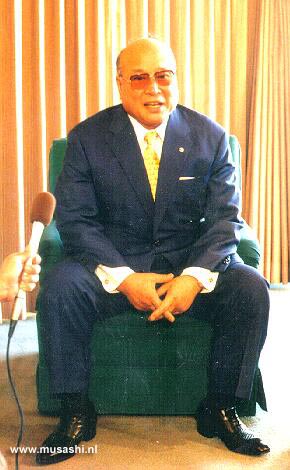
Old message to the Kyokushin members by Sosai Mas
Oyama
Kyokushin Karate will save the world
"I send this message to all of you with a
lament for the confusion that exist in the world"
We are a strong organization that maintains the same belief, purpose,
and idea without consideration of the frontier, race, or religion.
Together we choose our own destiny, and we even consider ourselves as
one big family, because of this I decided to send this call out to all
of you. These days, the egoism, synonymous of individualism, the
licentiousness, and the indolence instead of liberty are the common
denominator between the youth well fed and well dress on some liberals
countries. The immorality go on (advance) and the decency become
relaxed.
Not only the spirit but also the body have been damage because of the
bad habits people have to choose their food, which have to depend on
preservatives in order to preserve there foods. This inclination
(tendency) are more notorious on places called developed countries. On
the other side there are countries like the ones in Africa where they do
not have even the guarantee of a bite of food, as a consequence they
become exposed to famine.
From the national point of view we can observe some countries taking
advantage of others for their own benefits. We know that antagonism of
Ideology, races, and religions exists in this world. Unfortunately, it
looks like we have a long way to go before we can establish peace in
this world. I as a Budoka and one who have dedicate my life to Karate,
can not avoid been deeply concern about these phenomenon. Under these
circumstances it is very natural for all of us to arm ourselves
physically with Kyokushin Karate, however what is more desirable is to
arm ourselves spiritually. In a confuse world, if we only pursue the
physical force of karate, and neglect to obtain the spiritual part of
Karate, then is very easy to divert ourselves from the path of
rectitude.
Then, how we can arm our spirit? This can be done by Kyokushin Karate,
with their spirit and ideology, to became a reasonable human been. There
are no witness if there are not tangible prove, not credibility if we do
not have an evidence, not respect if we do not have a believe. Kyokushin
Karate is stimulant, because the physical force and the spiritual
superiority is evident. This is the Kyokushin Karate as a Martial Art.
The ideology of Kyokushin Karate put emphasis on the family and our
homes. In other words, the essence of Kyokushin spirit is " Bend your
head and rise your eyes, keep your mouse closed and free your mind, as a
starting point you should serve other with filial humility ". "Bend your
head and rise your eyes" mean that you must be ambitions, but always be
modest with with your words and your behavior. "Keep your mouse closed
and free your mind" mean that you must not show to much your own feeling
and be generous to others. You should be friendly and make diligent
effort, also be honest in everything you do. "With filial humility as a
starting point" mean that this filial humility toward your parents is
the center of everything. This loyalty will allow you to be modest,
respect the sky, believe in God, be humble with your parents, trust on
your friendship, and respect your teachers, all of this will drive you
to love your home, your city of birth, and your country. "Serve others"
mean that you must contribute to the people around you, in others words
contribute to society. This also mean be loyal to your country.
Again I will like to emphasis the fact that the Kyokushin spirit and the
ideology of Kyokushin Karate have a significant meaning in today world,
in which to sacrifice the society and your country to found your own
happiness is very common. All of you who love Kyokushin Karate should
also arm themselves spiritually and physically. I would like to
emphasize that there is no other than the spirit of Kyokushin that could
save this confuse world of today. I have travel abroad 280 times on the
past, to spread, to teach, and compete on Karate. Thanks to those visit
and the cooperation of the Chiefs in charge of each country of the
world, the Kyokushin Karate have become a big organization of 12
millions of adepts in 123 countries, the number is not small. We are a
well organize organization and we can consider ourselves like a big
state.
As I have always toll you, Kyokushin Karate is expanding trough the
nationals frontier, races, religion, and Ideologies. Overcoming these
barriers we should arm ourselves with the Kyokushin spirit in the real
sense of the word to become an influent body, so we can save this
confuse world. I am very anxious respect to the end of this century. We
should eliminate the crisis of the war and make a healthy and peaceful
world. I am sure you will understand my feeling. I would like to request
you to make all the effort possible, in your own countries to obtain a
real peace on this planet. Once more I would like to insist over that
there is no other than the spirit of Kyokushin that could save this
confuse world. The Kyokushin KaiKan had tried to establish an
organization and promote Kyokushin Karate, however, now we think we
should emphasize on the strength of the spirit and also on the formation
and development of character. Osu !
MASUTATSU OYAMA
Director of the International
Karate Organization
KYOKUSHINKAIKAN
